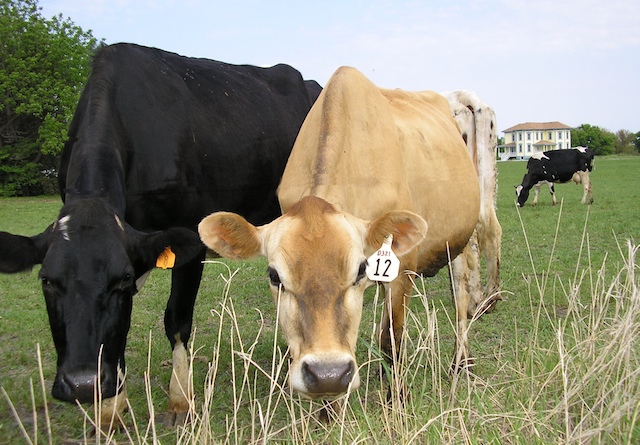Let me tell you about Picket Fence Creamery. (Though I warn you, I have an ulterior motive for doing so.)
The business is run by the Burkhart family in Woodward, Iowa. They have 80 acres and 80 “working girls”—Jersey cows—which provide the milk that is turned into skim, 2 percent and whole milk; butter; ice cream; whipping cream and cheese curds.
The milk is produced without the use of artificial hormones, and the cows spend most of their hours outside on those 80 acres.
And when I lived in Iowa, I bought their dairy products almost exclusively. Here’s what I love about Picket Fence:
- It’s a family-owned operation. The picture of Jill and Jeff Burkhart with their children, Jenna and James, is on their website, and if you go to their farm store to purchase products, those are the same faces you’ll see working there or giving tours of the farm. (Some of the faces, anyway, as they do also have employees, and their store includes goods from 100 other families in the region.)
- I was first introduced to Picket Fence products not at the farmers’ market, or by going to their farm, or any of the other hoops a person typically has to jump through to get local food. I picked up a gallon of Picket Fence milk at the chain-owned grocery store where I was going to buy food anyway. The Burkharts have recognized that getting their products into the hands of consumers means putting their products along the well-worn ruts we are used to traveling already—which includes the dairy aisle at the grocery store.
- They care about making a healthful, quality product. They don’t use the hormones that larger dairies may use to increase production, and the non-homogenized (“cream line”) milk is vat pasteurized, which retains flavor and nutrients, according to the Burkharts. I haven’t seen the research on the nutrients, but I can attest to the superior flavor.
- The cost is higher than a typical gallon of milk, but it still fits in my budget. This is in part because Picket Fence milk is not certified organic, even if they follow some (perhaps all) of the rules of organic production. I reported on an organic conference in Iowa some years ago, when there were some heated debates about organic certification. There was, and perhaps still is, a divide between the old-school organic producers who wanted to stay small, and the organic producers who wanted to spread organic to the masses on an industrial scale. The rules ended up tilted toward the industrial model, and certification costs are quite high for small producers. They are high for bigger producers as well (though they are better able to bear it), which affects the cost of the “certified organic” label in the grocery store. I would like to support the organic label, but only on payday am I feeling flush enough to do so. The rest of the month, our milk-drinking household downs way too much of the stuff for me to keep paying organic prices. Picket Fence runs their business in a way I want to support, and at a price point where I feel I can afford to support them.
I am not telling you all about Picket Fence just to get the word out about their business, though I am happy to do so, if any Iowans are reading this.
I am writing because I want someone in the James River Valley to copy them.
One of the benefits of moving back to my family farm in South Dakota is that we are now producing much of our own food: We started with garden produce, then added eggs, pork and most recently beef.
But we are not going to add dairy. Dairy is a lot of work, and there are limits to our time and energy, when our own farm isn’t the only thing we do. And all the dairy farmers who’ve gone out of business in our area can tell you that dairy, done without the creamery (i.e., selling to the market rather than selling direct to a customer), does not pay.
But if a family wanted to copy Picket Fence’s model, starting a creamery business like the Burkhart family did, I think there would be a market for it.
I went to the Northern Plains Sustainable Agriculture Conference in Aberdeen last weekend, which just keeps growing. Almost 600 people attended this year, which I think is a testament to the number of people looking for alternative ways to farm, and also the increasing number of consumers hungry for a more authentic connection to their food and the farmers that grow it. I will admit that I go in large part because the food is wonderful—farmers donate the ingredients, which are prepared by Ramkota’s chef. Yet despite all the delicious donated food, no farmer donates any dairy products. I think many of those farmers, who were also attendees, are no longer doing dairy. But boy, would they love to have some good old-fashioned milk.
I invite a Dakota family to consider it. I guarantee you’ll have at least one very dedicated customer.
Read more about Picket Fence Creamery at http://www.picketfencecreamery.net/.
Heidi Marttila-Losure is editor of Dakotafire Media, which brings together community journalists in the James River Valley of the Dakotas to report on regional issues. Read more Dakotafire stories at www.dakotafire.net. Marttila-Losure lives on and works from Dakota Sisu Farm near Frederick, S.D., which has been in the Marttila family for 127 years.

Leave a Reply